I used the body of rather small squid. The stuffing is lump crab meat (not canned), minced shallot, minced fresh tarragon (from our garden) and basil. I seasoned it with salt and pepper. The proportions are sort of arbitrary as I made it. Stuff 2/3 of the squid body with the crab meat stuffing and close it with a tooth pick. I sauteed it in a frying pan with a bit of olive oil for 3 minutes on each side and added a small pat of butter and then put the frying pan in a 450F oven for 3 minutes to complete the cooking. Since there was stuffing left, I added a bit of mayonnaise and Dijon mustard and made small crab cakes as well.
Sunday, August 15, 2010
Small squid stuffed with crab meat イカのカニ肉詰め
Friday, August 13, 2010
Store bought sushi from a near-by market アメリカ市販のお寿司
This post is to remind those people privileged enough to have easy access to quality sushi and bento boxes, particularly in Japan, how good they have it. In the past 10 years or so, increasing numbers of gourmet markets in the U.S. as well as even regular supermarkets started carrying sushi. In many food courts like the one in Union station, you can find small sushi bars mainly for take-out. Some gourmet markets even have a small sushi bar in the store. Some cafeterias may even offer a box of sushi (mostly rolls). The quality of the sushi served in these places, however, often leaves much to be desired. If we like to have take-out sushi for a party, our best bet is to place a take-out order in our favorite sushi bar for pick up just before the party.
This one was bought from the near-by gourmet market. It is made on the premises, but not to order, the plastic sushi boxes are placed in the cold case. So, sometimes these sushi boxes may be sitting in the cold case for quite some time. I served the sushi on a plate with my asazuke and real wasabi to make it more presentable. I also made a tofu and nameko (small slimy Japanese mushroom) miso soup with a garnish of chopped scallion and myouga.
While the fish, luckily was fairly fresh if somewhat spongy, in general the quality of the sushi was dismal. As you can see in the picture the California roll barely held together. The rice balls were huge (in the U.S. big is better) and unless we practically choked ourselves stuffing them into our mouth in one bite they quickly fell apart while trying for a more manageable two bites. The rice was especially disappointing. It turned out to be dry and hard without much vinegar flavor. Although sushi means vinegared rice for some reason much of the sushi sold this way seems to leave it out--(saving costs? Americans won't notice?) So why did we even bother buying this stuff? It's better than nothing when you need a sushi fix for lunch. Desperate times call for desperate measures (Due to recent demands at work and other factors we did not have a chance to visit our sushi bar much this summer). At least, the miso soup was excellent (because I made it). We have to hit the sushi bar soon!!
Wednesday, August 11, 2010
Gambas al Ajillo 海老のニンニクオリーブオイル焼き
This is a quintessential tapas dish. As far as I am concerned, any good tapas dish can be a good Izakaya food. Many years ago, our Spanish friend served this to us at a small party held in his backyard. Since then, this "gambas" became our favorite and quick snack accompanying a drink. I think the way I make this dish is based on the recipe in my old tapas cook book with my slight modification (of course).
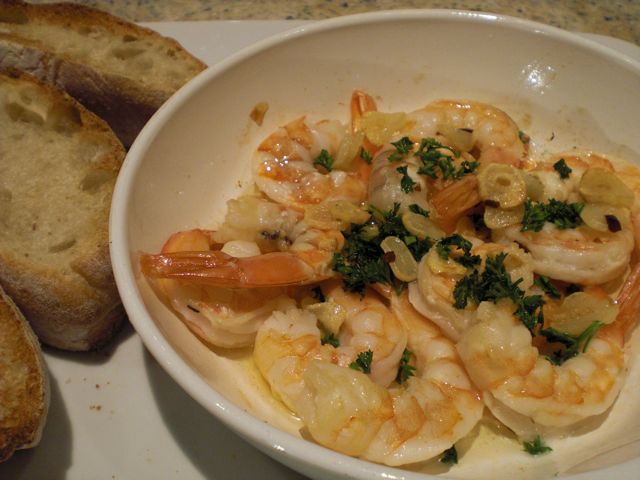
Shrimp: For this dish, relatively small shrimp (20-25 count/lb) works best. Since the vast majority of shrimp we buy here are previously frozen and thawed at the store (they say "for your convenience" but sometimes they are sitting in a case for several days after thawing), I rather buy frozen raw shrimp and thaw it myself. For quick thawing, I use running tap water. Some say the flavour will be lost in the running water but it is quick and convenient for me. Sprinkling salt on the shrimp after thawing appears to bring back some briny flavours of the ocean. This one is peeled and deveined except for the tail segment. I dry them on a paper towel.
I use a small flat Pyrex pan as seen above but any small flat pan will also work. I add 3-4 tbs of good quality olive oil (olive oil is an important part of the dish and we dip the bread to soak it all up). I thinly slice garlic (2-3 fat cloves) rather than finely mincing it. I slowly fry the garlic pieces on a low flame with red pepper flakes (whatever amount you like) until they are fragrant and the garlic slices are slightly browned. "Slowly" is important since the garlic flavour is transferred to the oil better and the garlic slices become crispy (become garlic chips) without imparting a burnt bitter taste. Take the garlic chips out of the pan and put them on a small paper towel lined plate and set aside. I then fry the shrimp in the garlic scented olive oil for 30 seconds on each side or until just done and take it off the heat. I sprinkle chopped parsley, lemon juice on the cooked shrimp and garnish with the garlic chips. You could sprinkle Spanish paprika if you wish (mostly for decoration). I do not add any salt since it was already added after the shrimp thawed.
For this, we need a rustic and crusty bread like good baguette or ciabatta. We happened to have a very nice crusty ciabatta from a local bakery. We opened the last bottle of Vilafonte. It went with the meal very well.
Shrimp: For this dish, relatively small shrimp (20-25 count/lb) works best. Since the vast majority of shrimp we buy here are previously frozen and thawed at the store (they say "for your convenience" but sometimes they are sitting in a case for several days after thawing), I rather buy frozen raw shrimp and thaw it myself. For quick thawing, I use running tap water. Some say the flavour will be lost in the running water but it is quick and convenient for me. Sprinkling salt on the shrimp after thawing appears to bring back some briny flavours of the ocean. This one is peeled and deveined except for the tail segment. I dry them on a paper towel.
I use a small flat Pyrex pan as seen above but any small flat pan will also work. I add 3-4 tbs of good quality olive oil (olive oil is an important part of the dish and we dip the bread to soak it all up). I thinly slice garlic (2-3 fat cloves) rather than finely mincing it. I slowly fry the garlic pieces on a low flame with red pepper flakes (whatever amount you like) until they are fragrant and the garlic slices are slightly browned. "Slowly" is important since the garlic flavour is transferred to the oil better and the garlic slices become crispy (become garlic chips) without imparting a burnt bitter taste. Take the garlic chips out of the pan and put them on a small paper towel lined plate and set aside. I then fry the shrimp in the garlic scented olive oil for 30 seconds on each side or until just done and take it off the heat. I sprinkle chopped parsley, lemon juice on the cooked shrimp and garnish with the garlic chips. You could sprinkle Spanish paprika if you wish (mostly for decoration). I do not add any salt since it was already added after the shrimp thawed.
For this, we need a rustic and crusty bread like good baguette or ciabatta. We happened to have a very nice crusty ciabatta from a local bakery. We opened the last bottle of Vilafonte. It went with the meal very well.
Monday, August 9, 2010
Grilled salmon with Ponzu soy sauce and Grated Daikon radish 焼塩鮭のポン酢みぞれ和え
I grated the daikon and squeeze out the excess liquid (about 1/4 cup) and added ponzu soy sauce (about 1 tbs from the bottle). I then crumbled the grilled salmon leftovers and mixed them into the daikon. I splashed Yuzu juice (from the bottle) on the top and garnished with finely julienned radish and finely sliced scallion (I used the green part for color). A simple quick dish but it was quite nice with cold sake. A good start.
Saturday, August 7, 2010
Grilled egg plant 焼き茄子
In Japan, you can get such nice and fresh vegetables, including cucumbers and eggplants, much more easily than in the U.S.. There are several kinds of Japanese eggplants; some can be even eaten raw ("water eggplant" or "Mizunasu" 水茄子). I like "Kamonasu" 賀茂茄子, famous for being used in Kyoto cuisines. You can not get these easily in the U.S.. The kind of eggplants we can get here are limited to mostly Western varieties. Occasionally, what they call a "Japanese" eggplant is available (a light purple and small elongated kind) but I do not recall seeing similar eggplants in Japan. I tend to use small Italian eggplant and Zebra eggplant for my Japanese style cooking but, sometimes, it does not work out. Simply grilled Japanese eggplant, "yakinasu" 焼き茄子 is wonderful if the eggplant is good. I found a small (baby) Italian eggplant which looked very good but bought only one, because the last time I tried to make this from Italian eggplants, it was pretty bad. I am sure, because I only got one this time, it turned out pretty good and I wish I had bought more.
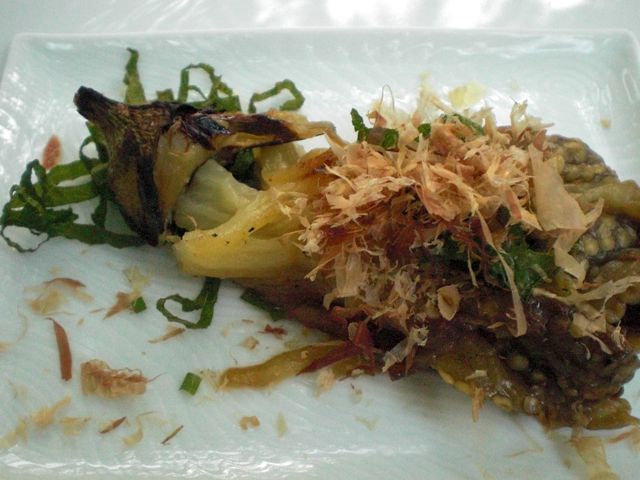
Before grilling, I just prick the skin of the eggplant all over with the tines of a fork or a tip of a bamboo skewer to prevent from the eggplant from exploding (This happened once in our Weber grill. We heard a big "bong" noise. A small puff of ash came out the bottom vents of the grill. Upon investigation we found the meat of the eggplant spread all over the inside of the lid. Nothing was left on the grill except for few fragments of the charred skin.) After 15 minutes or so, the eggplant is thoroughly cooked (turn several times during the cooking) and soft as seen below. Make sure the eggplant is completely cooked. Using chopsticks or tongs, peel off the skin holding the cap while it is hot. Using a small knife or a bamboo skewer, cut the eggplant along the long axis (you can plant the skewer in the meat near the cap and then grab the cap and pull the skewer through). repeat this a few times to make long strands of eggplant. Cut at the cap but I keep the cap for presentation. I garnish with dried bonito flakes and chiffonade of perilla. As a seasoning, I can use just soy sauce but I happened to make my dipping sauce for other dishes we had (dashi 2 parts, mirin 1 part and soy sauce 2 parts) so I used my dipping sauce.
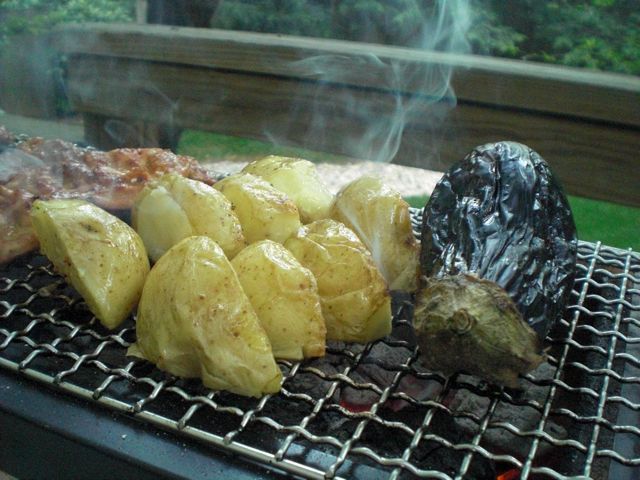
Eggplant is almost done along side potatoes which are being grilled for "Jagabata" or potato with butter.
Thursday, August 5, 2010
Grilled Trout 鱒の塩焼き
The types of fish, especially whole fish, we can get in a regular market, is very limited. Among the whole fish we can get almost all the time is a trout. I thought I bought trout that was just cleaned but it turned out this one was deboned and butterflied as well. Since we were planning to grill outside, I decided to grill this fish as planned. I sprinkled it with salt and pepper all around and put sprigs of fresh thyme and slices of lemon inside the fish.

Since I do not like the skin to stick to the grill, I used two large metal skewers so that I can suspend the fish over the charcoals. The fish were fairly large but they just fit side-by-side.
 Grilled whole fish, in general, is difficult to present in a pleasing way. While trout, as a white fresh water fish can be rather bland, and if not fresh, inedible, this fish had a nice thyme flavor and the barbecue imparts a lovely smokiness. When we were in California, we used to cook trout all the time, because it was almost the only whole fish we could get, but we have not have had trout for a long time.
Grilled whole fish, in general, is difficult to present in a pleasing way. While trout, as a white fresh water fish can be rather bland, and if not fresh, inedible, this fish had a nice thyme flavor and the barbecue imparts a lovely smokiness. When we were in California, we used to cook trout all the time, because it was almost the only whole fish we could get, but we have not have had trout for a long time.
I fondly remember the large juicy grilled herring I ate at the Robatayaki/Izakaya specializing in grilled fish, which was next door to the my old favorite "Oden" place, Kastuya, before it moved from the quaint dead-end alley way near Oodouri park 大通公園 in Sapporo 札幌.
I fondly remember the large juicy grilled herring I ate at the Robatayaki/Izakaya specializing in grilled fish, which was next door to the my old favorite "Oden" place, Kastuya, before it moved from the quaint dead-end alley way near Oodouri park 大通公園 in Sapporo 札幌.
Monday, August 2, 2010
Myouga pickled in sweet vinegar 冥加の甘酢漬 Myouga asazuke 冥加の浅漬
This is probably the last installment of my "myouga" series. This year's crop was not as good as other years but we had enough myouga to enjoy.
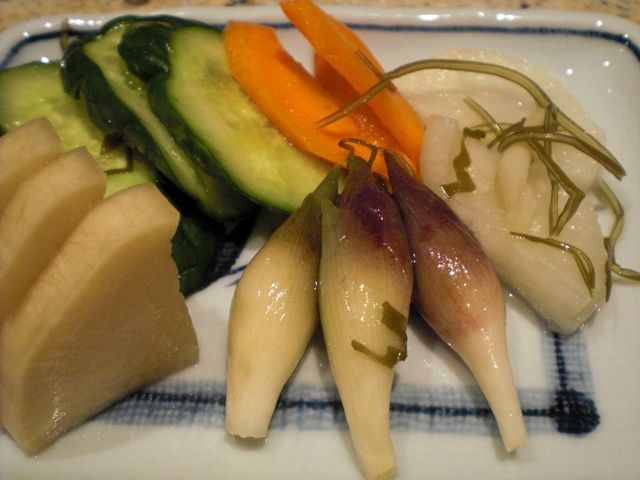
I think I am running out of myouga recipes. You could of course use finely chopped myouga as a condiment for anything including cold tofu 冷や奴, miso or clear soup, chawanmushi 茶碗蒸し, noodle dishes, sunomono 酢の物 dishes etc.
The picture below is myouga in sweet vinegar. This is a rather common preparation of myouga and I was told you could get this as a commercial product (in Japan). The recipe is rather simple. I first make sweet vinegar by dissolving sugar in Japanese rice vinegar (I used about 100m of vinegar with 4 tbs of sugar but the proportion is to your taste. I thought this was a bit too sweet but my wife thought it was just fine). I just microwaved it for 30-40 seconds or until the vinegar is warm enough to dissolve the sugar completely. Do not boil, it will make the vinegar less potent. (On the other hand, you may want to gently boil it in a pan to make the sweet vinegar more mellow). I then blanched the cleaned myouga, drained and added it to the sweet vinegar while the myouga are still hot. I keep this in a refrigerator for at least 3 days before eating. The one shown here is about a week old and still nicely crunchy with a sweet vinegar flavor mixed with the distinctive myouga taste. I do not know how long this will keep but I am sure, at least, several weeks. This is perfect for sipping sake or with rice.
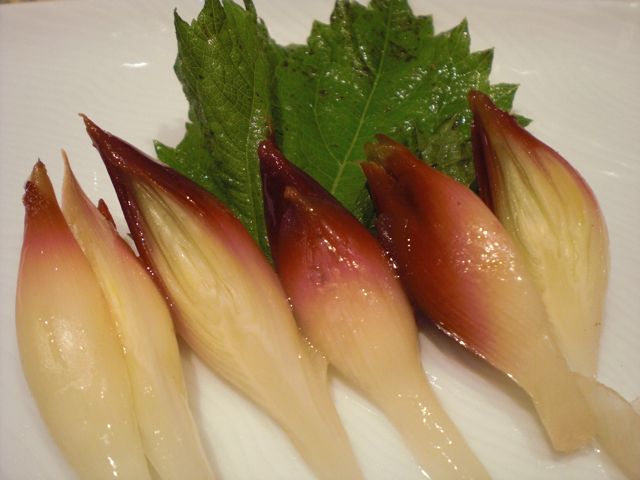 This is an assortment of asazuke 浅漬け (cucumber, carrot, daikon, in the back from left to right) and beer marinated daikon (front left) but the main item is, of course, myouga. I made the other vegetables exactly the same way as I posted before but I did not add ginger or hot pepper flakes. In addition to the nice myouga buds, I also added the chopped up stalk of myouga as well. This one has a purely myouga flavor with nice crisp texture.
This is an assortment of asazuke 浅漬け (cucumber, carrot, daikon, in the back from left to right) and beer marinated daikon (front left) but the main item is, of course, myouga. I made the other vegetables exactly the same way as I posted before but I did not add ginger or hot pepper flakes. In addition to the nice myouga buds, I also added the chopped up stalk of myouga as well. This one has a purely myouga flavor with nice crisp texture.
Saturday, July 31, 2010
Sliced roasted pork wrapped potato salad ポテトサラダのローストポーク巻き
This is another nothing dish I quickly made from leftovers. You could make this with commercial ham as well.
I just put a small amount of the potato salad on the sliced pork and made it into a roll and cut it in half. I served it with a cornichon. This goes well with any drink; wine, beer or sake. We had this with sake. Smokey pork flavor really matched well with the creamy starchy potato salad. Although the presentation can be improved, this is such quick nothing dish yet very good and satisfying.
Thursday, July 29, 2010
Myouga, broccoli and cumber salad with sesame mayonnaise 茗荷、ブロッコリ、キュウリの胡麻醤油マヨネーズ和え
For two servings like the one in the picture, I blanched broccoli florets (about 8) and shocked them in ice cold water, so they are green and crunchy. I peeled and cut one medium tomato into 8 wedges (this was very ripe home grown-by my friend- tomato), and halved and thinly sliced myouga (4-5), and cut a cucumber in "Jabara" 蛇腹 (1 American mini-cucumber)which was further cut into a bite size (a bit larger than half inch chunks) and lightly salted.
Dressing: I dry roasted white sesame seeds (2 tbs) in a frying pan for 2-3 minutes until they slightly browned and fragrant. I tipped them into a Japanese mortar or suribachi and ground them coarsely (some oil will come out). I added sesame paste (1 tsp) and soy sauce (2tsp) and mayonnaise (2 tbs, happened to be home made) and mixed. Taste and adjust the amount of soy sauce if needed.
I just arranged the vegetables, poured the dressing and topped it with white sesame seeds.
This is a hybrid Japanese/Western salad but the combination worked well.
Tuesday, July 27, 2010
Myouga, chicken and duck tenderloin tempura 茗荷、鶏と鴨の笹身の天ぷら
We do not particulary like to make tempura of myouga because the myouga seems to lose its flavor when cooked, but this one came out ok. Again, the myouga was used as a part of the tempura assortment rather than the main item.

The chicken tenderloin was stuffed with minced pickled plum or "umeboshi" 梅干し which is called "bainiku" 梅肉, then wrapped in perilla leaves. This is exactly the way I usually make this dish (Left in the back in the above picture). Since I separated the tenderloin from the duck breast when I made a duck breast dish, I wrapped it with a small rectangular sheet of nori 海苔. Whenever nori or aonori is used in this fashion or mixed into the tempura batter, it is called "Isobe age" 磯辺揚げ meaning "Rocky seashore fries" (Right in the back ). The tempura batter is my usual; a mixture of ice cold water and cake flour (I did not add potato starch this time because I was a bit lazy). I also fried this using the shallow frying method rather than deep frying.
I fried the myouga last, briefly and at a higher temperature than other items, which helped retain the flavor. When you cook myouga (such as in a miso or clear soup) the unique flavor of myouga diminishes quickly. I served this with an wedge of lemon and green tea salt.
I fried the myouga last, briefly and at a higher temperature than other items, which helped retain the flavor. When you cook myouga (such as in a miso or clear soup) the unique flavor of myouga diminishes quickly. I served this with an wedge of lemon and green tea salt.
Sunday, July 25, 2010
Miso pickled Myouga みょうがの味噌漬け
In any case, I just smear enough red miso to coat all freshly harvested, washed and dried myouga. I put them in a Ziploc bag for over 10 days in a refrigerator and it is ready to eat. This is about 2 weeks old. Just wash off the miso and cut in half and serve. This is a perfect accompaniment for sipping sake. The myouga is still tastes fresh and is crunchy yet has an added nutty salty miso flavor.
We have been harvesting myouga every weekend for the past few weeks. This year's crop is not as plump, big, or numerous as other years. The flavor, however, is very strong. Nonetheless even though small, some started flowering (far left). As I said before, once it flowers, the bud became loose and soft and does not taste good.
Saturday, July 24, 2010
Home grown tomatoes 家庭菜園トマト
Friday, July 23, 2010
Cold asparagus soup 冷製アズパラガス スープ
It has been extremely hot especially in recent days. By my wife's request, I made cold asparagus soup. She says it is the essence of everything good about asparagus. It is a perfect starter dish for hot summer days.
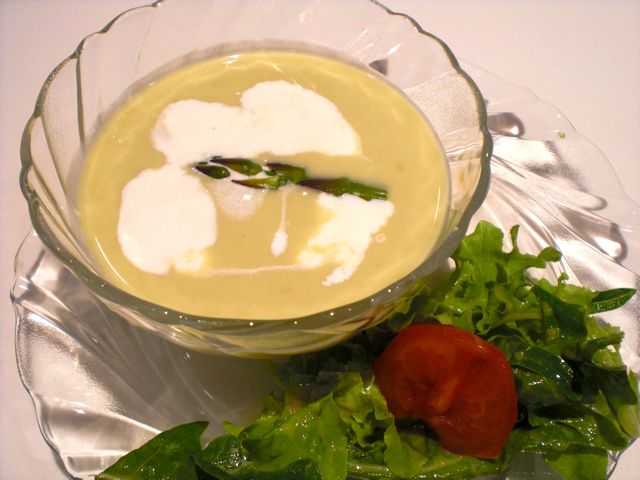
For about 4 servings, I used asparagus (10, thick ones, not the pencil kind), white potato (one medium), onion (one, small), bay leaves (3), chicken broth (16 oz) and cream (1/4 cup). First I cut off the tips of the asparagus (about 1 inch from the top) and blanched them for 1 minute. Then I shocked it in cold water. I set them aside as a garnish. I then cut off the very bottoms which are woody and discard them. I slice the remaining stems on the bias in 1/3 inch thick. I skinned and diced the potato (small dice). I sauteed finely diced onion in olive oil (1 tbs) for 2-3 minutes or until it becomes semitransparent. I then added the sliced asparagus, diced potato and saute for another minute. I added the chicken broth and three bay leaves. Once it come to the boil, I turn down the flame to low and put the lid on. I let it simmer for 15-20 minutes or until all the ingredients are soft and cooked. I remove all three bay leaves (I count them very carefully) and, using an immersion blender, homogenize the soup. Toward the end, I add 1/4 of a cup of cream. I taste it and season with freshly ground white pepper and salt. I season a bit more severely than I would for hot soups since the taste will be somewhat muted when the soup is served cold. I did not strain the soup but you could strain it to make it perfectly smooth. Cool it down to the room temperature and then chill it in a refrigerator for, at least, several hours. I add a bit more cream when I serve it and garnish with the asparagus tips. Perfect cold soup to start hot summer days.
Wednesday, July 21, 2010
Grits and poached egg グリッツとポーチドエッグ
This could be a "shime" 締 ending dish or, more traditionally, a breakfast. It is a variation of "Okayu" お粥 or porridge but in a US Southern style. It is a very comforting and nice starch dish. This one is prepared by my wife and I only help by chopping up the chives and making the poached eggs.
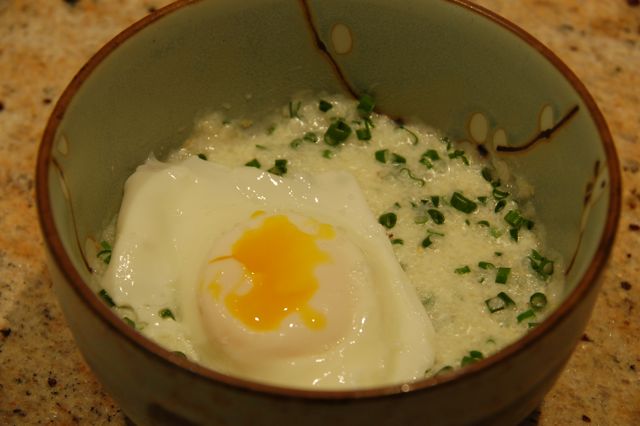
Grits is a very Southern food and my wife is not even from the South but we adapted this dish for some reason. Instead of the more traditional grits which is eaten as a breakfast with additions of cheese, butter or maple syrup (a Northern addition to a Southern dish...don't ask why), we make it savory. We cook the grits in milk instead of water. Just in case you are not familiar with grits, it is coarsely ground alkaline-treated hard kernel corn. Alkaline treated corn prevents the development of a niacin deficiency (Pellagra) especially if your main diet consists of corn. I do not know who first figured this out but certainly American Indians ("hominy" from which grits is made) and Mexicans ("masa harina" for corn tortilla is also made from alkaline treated corn) must be among the first. This treatment also created another flavor different from regular corn meal. Grits and polenta are similar yet distinctive in their taste. The description below is how my wife makes grits.
 Grits: She prefers to use "Quick" grits (Quaker brand) rather than "Instant" grits. Quick grits, which has been pre-steamed and then dried, requires about 5 minutes cook time but it is more "authentic" in flavor and consistency than the "instant" variety. True old fashioned stone-ground grits will take way too long to cook.
Grits: She prefers to use "Quick" grits (Quaker brand) rather than "Instant" grits. Quick grits, which has been pre-steamed and then dried, requires about 5 minutes cook time but it is more "authentic" in flavor and consistency than the "instant" variety. True old fashioned stone-ground grits will take way too long to cook.
For two small serving, in a small but deep pan, add milk (one cup, we use 1%) and just when it starts boiling, add salt (1/4 tsp) and grits (3 tbs) while stirring with a whisk, turn down the flame and cook covered for 5 minutes until all the milk gets absorbed. Add chopped fresh chives (3-4 tbs). She adds 1 pat of butter (1/2 tbs) but no cheese.
Poached eggs: I poach eggs very simply without any vinegar and without any special techniques or gadgets but works all the time. I used a 8 inch frying pan with non-stick surface and with a high side wall so that it can have enough depth of water to completely submerge the eggs. After the water comes to a gentle boil, I adjust the heat so no or only few bubbles form in the water (many bubbles result in egg-drop soup). I then add 1 tsp of salt (just for seasoning). I crack the egg into a small ramekin or bowl and gently slide the egg into the water. Repeat the process. After the white is set and the egg yolk becomes opaque on the surface (4-5 minutes), using the perforated spoon or silicon spatula gently pry the bottom of the eggs from the surface of the pan; take care not to break the yolk. The eggs should come loose without a problem because of the non-stick surface. Pick up the egg using a perforated spoon and drain on a paper towel-lined plate.
Place the grits in a bowl and put the poached egg on top. Sprinkle with salt and serve. For breakfast my wife serves this with her home-made buttermilk biscuit (another Southern specialty) but for the "shime" dish serve as is. Break the egg yolk and mix it with the grits. Even if you are not from the South, you will like this dish.
Monday, July 19, 2010
Pasteurized eggs and homemade mayonnaise 滅菌卵と自家製マヨネーズ
When I made cold ramen noodle, I discussed the risk of Salmonella food poisoning when eating raw or undercooked eggs. Since we like runny egg yolks and many Japanese cuisines call for raw or undercooked eggs, we have been using "free ranging and organic" eggs for these purposes, which are reportedly safer than regular mass produced eggs. Now we found we could get pasteurized eggs. The price appears to be about the same or even slightly cheaper than free ranging organic eggs. As you can see, eggs have red "P" in a circle stamped on them indicating it is "P"asturized.

In the mixing cup of an immersion blender, I put two egg yolks, lemon juice and rice vinegar (1 tbs each), salt (1/2 tbs), Dijon mustard (1 tbs, smooth kind), a pinch of sugar and vegetable oil (1 cup) plus olive oil (1/2 cup, extra-virgin olive oil). I put the immersion blender to the bottom of the mixing cup and pulsed it several times as emulsion develops in the bottom. As more emulsified material appears, I continuously blend and also raised the tip of the blender off the bottom to mix everything. In 30 seconds, nice mayonnaise is made.
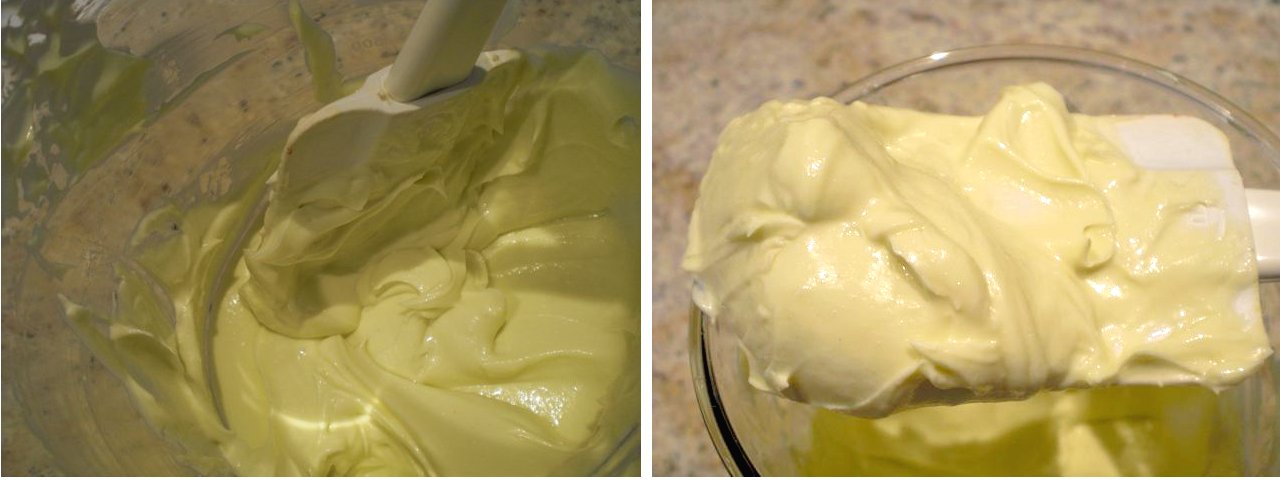
It tastes good. Because of the extra-virgin olive oil I used, it looks slightly greenish and you can taste both olive oil and egg yolk with nice acidity. Yolks from the pasteurized eggs work exactly same as yolks from regular eggs. Sunny-side-ups also look and taste identical to regular eggs, although the egg white looks slightly firmer than one in a regular egg.
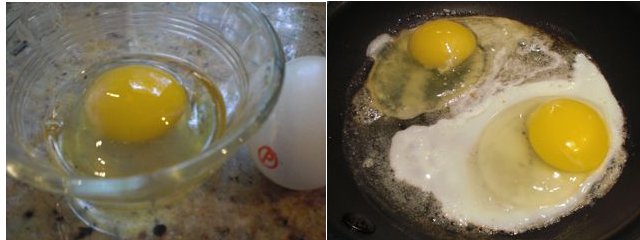
Saturday, July 17, 2010
Braised Shirataki with Tarako roe 鱈子と白滝の炒り煮
I decided to make this dish because I found frozen tarako in our freezer which appears not to be high in quality (I must have bought it frozen sometime ago). Shirataki, which means "white cascade" in Japanese, is Konnyaku or Konjac made into thin noodles by extrusion and is often used in Sukiyaki. It does not have many calories and, for that matter, not much taste but can absorb any flavor you add to it.
Tarako mixture: First, remove the tarako roe by slicing the membrane and, using a back of the knife, scrape off the roe from the membrane and put it in a small bowl. For the one package of shirataki, I used two small sacs of tarako but the amount is totally arbitrary. I add 1-2 tbs of sake and a dash of Tabasco (optional) and mix so that it will have nice thick saucy consistency.
Shirataki: I drain and wash one package of shirataki and cut into three portions to make the noodles more manageable and cook it in a boiling water for 1 to 2 minutes (mostly to remove the peculiar smell konnyaku and shirataki always have) and drain. Put the shirataki noodle in a dry non-stick frying pan on a medium flame. Stir to let the excess moisture evaporate (so that it can absorb more liquid seasoning). I add sake and soy sauce (1 tbs each) and stir until the liquid is almost all gone. You could add mirin here to make this dish a bit sweet.
Add the tarako mixture and keep stirring until the color of the tarako become white and cooked through. Since tarako is salty you may adjust the amount of soy sauce accordingly. I mix in chopped chives (or scallion). I garnish with chopped chives when serving.
This dish has an interesting texture contrast of cooked roe and shirataki noodle. The addition of Tabasco adds a very slight and slow acting pleasant heat to the dish. Sake is definitely called for.
Friday, July 16, 2010
Omelet with tarako and nori 鱈子と海苔入り卵焼き
I made this dish at the same time I made "Braised shirataki and tarako" since I had extra tarako. This is one of many variations of Japanese omelet called "tamagoyaki" 卵焼き which I posted one previously.

Tarako mixture: First, remove tarako roe by slicing the membrane and, using a back of the knife, scrape off the roe from the membrane and put it in a small bowl. For three eggs, I used two small sacs of tarako but the amount is totally arbitrary. I add 1-2 tbs of sake and dash of Tabasco (optional) and mix so that it will have nice thick saucy consistency.
For two to three servings (two to three slices per serving), I crack eggs (three, large) in a bowl and add mirin (1 tbs). I then add the tarako mixture and coarsely crumbled nori (half sheet), beat it using chop sticks to mix well. I also add chopped chives but this is optional.
As usual I use a Japanese square frying pan. On a medium flame, I add vegetable oil (1/2 tbs) and add 2/3 of the egg mixture and gently scramble until it is semi-solid. Using a silicon spatula, I push the egg mixture to one end of the square frying pan to make it into a rectangle shape. If needed, I add more oil in the empty portion of the frying pan and add the remaining egg mixture. Again using the spatula, let the egg mixture flow under the rectangle of the eggs by lifting the rectangle. Wait a few moments until the egg on the bottom is set but the surface is still wet. Start rolling the rectangle of eggs so that the surface is all covered with the last layer of the egg mixture. Make sure the end of the seam is well set (you may have to flip it over several times so that all four surfaces are set). I take it out and wrap it in parchment paper to shape (if need be, further wrap it in a bamboo sushi mat to shape - I did not do this this time) and let it cool. The end result is like the image below, a nice rectangular shaped omelet.
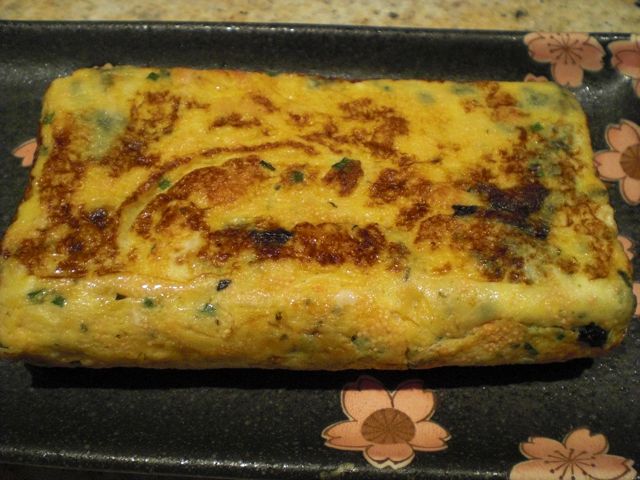
I sliced it and served it with grated daikon or "daikon oroshi" 大根おろし (add soy sauce just before eating), finely cut myouga and salted and vinegared cucumber cut in jabara 蛇腹. This is, again, a perfect small dish for sake. Myouga really added to this dish. Myouga flavor is very difficult to describe but it is not scallion or ginger-like and it is just unique.
For two to three servings (two to three slices per serving), I crack eggs (three, large) in a bowl and add mirin (1 tbs). I then add the tarako mixture and coarsely crumbled nori (half sheet), beat it using chop sticks to mix well. I also add chopped chives but this is optional.
As usual I use a Japanese square frying pan. On a medium flame, I add vegetable oil (1/2 tbs) and add 2/3 of the egg mixture and gently scramble until it is semi-solid. Using a silicon spatula, I push the egg mixture to one end of the square frying pan to make it into a rectangle shape. If needed, I add more oil in the empty portion of the frying pan and add the remaining egg mixture. Again using the spatula, let the egg mixture flow under the rectangle of the eggs by lifting the rectangle. Wait a few moments until the egg on the bottom is set but the surface is still wet. Start rolling the rectangle of eggs so that the surface is all covered with the last layer of the egg mixture. Make sure the end of the seam is well set (you may have to flip it over several times so that all four surfaces are set). I take it out and wrap it in parchment paper to shape (if need be, further wrap it in a bamboo sushi mat to shape - I did not do this this time) and let it cool. The end result is like the image below, a nice rectangular shaped omelet.
Thursday, July 15, 2010
Marinated tuna sashimi マグロのづけ
The quality of tuna sashimi we can get from Japanese grocery stores in the U.S. is a far cry from what you can get in Japan from such places as "depachika" デパ地下 or basement (Gourmet food) floors of Japanese department stores. Even in the U.S., New York, Los Angeles and San Francisco areas may be the only areas in which you may have better luck getting some decent sashimi items. Oh, I almost forgot San Diego, home of Catalina Offshore Products. I have posted a few dishes I make from low-grade frozen "saku" (a block for sashimi) of yellowfin tuna. Although this is always available in our near-by Japanese grocery store (the one which is still open), and I can keep it for couple of months in our freezer, it is not good---very lean with a mealy texture. Among the many techniques used to make this kind of sashimi more palatable is marinating in a mixture of soy sauce, sake and mirin, which is called "zuke" 漬け or づけ. Of course, you can use this technique for a good quality tuna as well if you so prefer. I often use this "zuke" technique for the tuna in my Yamakake やまかけ mostly for the taste even when I have a descent quality tuna. If you marinate the tuna over night, the texture will change to a more "slimy" (this is not an appropriate word since it has a negative connotation for Westerners. The Japanese word will be "nettori" ねっとり, which does not have a negative connotation) texture. I do not particularly like this texture but some (Japanese) people love this. This time, I made this dish based on the recipe I saw in the Asahi Newspaper Web and I kind of like it. It changes the texture but not to the point of sliminess and makes this low-quality tuna sashimi much more palatable.
Tuna block or "saku": First, I thaw one "saku" 柵 of frozen yellow fin tuna in the refrigerator overnight. I then do a "yubiki" 湯引き or "shimofuri" 霜降り process of plunging the tuna into boiling water for 5 seconds and then soaking it immediately in ice water for a few minutes until the tuna is ice cold again. Only the surface becomes white. This is similar to "Tataki" たたき technique which involves brief grilling instead of boiling. I dry the surface with a paper towel after taking it out from the ice water. I slice it on a slant (slice about 50-60 degree, instead of 90 degrees, from the horizontal surface of the saku) to make a less than 1/2 inch (or about 1 cm) thick but larger slices as compared to ones you slice perpendicular to the saku.
I serve this like sashimi with a Chiffonade of perilla leaves, chopped chives and thin slices of the white part of scallion (or whatever fresh herbs you like to use) with a dab of real wasabi. I think the timing of the marination, addition of sesame seeds, and ginger juice all work. Mixing light (colored) and regular soy sauce made the color of tuna sashimi darken to just the right color and make this low-grade sashimi taste and look like much better quality tuna sashimi. It tasted very good with a scant smear of wasabi. Only problem I had was that it tasted a bit too salty for me and I may reduce the proportion of soy sauce next time (my wife thought it was just fine). You could make a donburi どんぶり by placing the marinated tuna sashimi on (sushi) rice. This is indeed a great way to upgrade a low-quality tuna sashimi.
Marinade: Mix sake (1 part), mirin (1 part), light colored or "usukuchi" soy sauce 薄口醤油 (1 part) and regualr or "koikuchi" soy sauce 濃口醤油 (2 parts) with dry roasted coarsely ground white sesame seeds (2 tbs) and the juice from grated ginger (1 tbs). Although white sesame seeds you get from a Japanese grocery store are already roasted, I roast them again in a dry frying pan for 5 minutes or until the sesame seeds become fragrant and just start popping. I coarsely grind them in a "suribachi" すり鉢 or a Japanese mortar. This step is really worth the effort. You should smell a nice fragrance of sesame.
Marination: In a flat sealable container, I put the marinade and the tuna slices in one layer so that all the surface of the tuna is covered with the marinade. I let it marinate at room temperature for 10 minutes and then for 2 hours in the refrigerator. The timing is rather important since the taste and texture (especially the texture) will change depending on the length of the marination. I found two hours to be perfect.
I serve this like sashimi with a Chiffonade of perilla leaves, chopped chives and thin slices of the white part of scallion (or whatever fresh herbs you like to use) with a dab of real wasabi. I think the timing of the marination, addition of sesame seeds, and ginger juice all work. Mixing light (colored) and regular soy sauce made the color of tuna sashimi darken to just the right color and make this low-grade sashimi taste and look like much better quality tuna sashimi. It tasted very good with a scant smear of wasabi. Only problem I had was that it tasted a bit too salty for me and I may reduce the proportion of soy sauce next time (my wife thought it was just fine). You could make a donburi どんぶり by placing the marinated tuna sashimi on (sushi) rice. This is indeed a great way to upgrade a low-quality tuna sashimi.
Tuesday, July 13, 2010
Grilled squid with lemon and thyme レモン、タイム味のイカ焼き
This is a type of dish that sounded great in concept but had some problems in execution. I did not follow any particular recipe but thought that having thyme and lemon flavoured grilled small squid would be a nice appetizer.
The type of squid I can consistently get here is a small pre-cleaned (previously frozen) kind which tend to be loaded with water (They must absorb water during the preparation process). I had too-much-liquid-coming-out-of-the-squid problem before.
I marinated the squid in olive oil, lemon juice, grated lemon zest and fresh thyme, salt and freshly cracked white pepper for several hours in the refrigerator. I grilled the squid on a very hot charcoal fire but it failed to get nice char marks and sort of steamed. I have to assume it had so much water in the meat that the surface temperature did not rise high enough to form a char despite the hot charcoal fire. It was certainly edible but it did not have enough flavour and was somewhat tasteless. What a disappointment.
Sunday, July 11, 2010
Grilled squid, wakame and myouga in vinegar miso sauce イカとワカメ, 茗荷の酢みそ和え
This is a made-from-leftover dish and very similar to the dish I posted previously but since we harvested the very first myouga 茗荷, this is a preview of the myouga dishes to come. We grilled marinated squid (in lemon zest, olive oil, fresh thyme etc) few days ago but it was not a roaring success. I used this leftover squid, combined with a type of sea vegetable called "wakame" 若布, and cucumber to make this small starter dish. I added the star attraction--a garnish of myouga.
I thinly sliced cucumber (American mini cucumber) and salted the slices. I squeezed out the excess moisture and lightly dressed it with sushi vinegar. For "wakame", after re-hydration, I squeezed out the excess water and also lightly dressed it with sushi vinegar. Before dressing with a "sumiso" sauce, I again squeezed out excess liquid from both the cucumber and wakame. I sliced the left over grilled squid into thin rings.
Karashi sumiso sauce: This is my regular sumiso sauce with miso (I used red miso this time without any particular reason), sugar and rice vinegar with Japanese hot mustard.
After dressing everything in the sumiso, I garnished with a perilla leaf, sliced Campari tomato, and fresh myouga (just a cameo appearance of myouga here). Because of the karashi sumiso, the squid tasted better and the myouga has such a unique taste it really added to the dish.
We are still waiting for the myouga to get a bit larger.
Saturday, July 10, 2010
How to make a perfect grilled rice ball with crispy crust all around. 完璧な焼きおにぎりの作り方
By the way, a small white half moon shaped item is a Japanese turnip (ko kabu こかぶ) which was grown by our friend. It turned out that this kabu is rather spicy (hot).
Thursday, July 8, 2010
Natto soba 納豆蕎麦
Several things came together to inspire me to make this dish. First the cover picture on the cookbook "Takashi's Noodles" triggered the memory of a similar dish I occasionally had for lunch at a Soba restaurant in downtown Sapporo. Second, it has been really hot and muggy here--the kind of weather that calls for cold soba. In Japan, soba is a very popular lunch item and there are many restaurants specializing in soba and they do a brisk business during lunch. The combination of cold soba topped with natto 納豆 is rather classic and called "Natto soba" 納豆蕎麦 which was one of my favorites. I made this as a "shime" dish one night and found out my wife never had this before.
This is not a recipe per se since this is just a plate of soba and various garnishes which happened to include natto. A raw egg yolk usually accompanies this dish. Raw or undercooked eggs here in the U.S. are always iffy because of the potential for Salmonella contamination. We use "free-ranging" and "organic" brown eggs for dishes that are not fully cooked or have runny yolks. We do not know, however, if there is scientific or statistical evidence that these eggs are indeed safer than regular supermarket white eggs. (P.S. I found an article indicating that there is a lower risk of salmonella contamination in organic and free ranging eggs, although the risk is not zero. I also found that pasteurized shell eggs* are going to be available more widely in very near future.) We have been eating soft boiled eggs, poached eggs, and sunny side ups for many years and so far, (knock on wood) we have not experienced any ill effects. This time I used egg yolks from "Onsen tamago" 温泉卵, which I made from the brown eggs. This is a very peculiar Japanese way of cooking eggs, which, I am sure, I can describe in more details in a separate post.
I cooked dried soba noodle as per package instructions and washed them in cold running water and drained. I diluted a bottled noodle (concentrated) sauce in cold water to my liking. Natto was prepared my usual way. Other garnishes include thinly sliced (on bias) scallion , dried bonito flakes, thin strips of nori and an egg yolk from the onsen tamago. Just before eating, I poured on the dipping sauce. I took a dab of wasabi and worked it in by mixing all the items well. This is a perfect dish for hot summer days. By the way, my wife, who is not a card-carrying member of the Natto fan club, liked this dish.
* P.S. 2: We found Davidson's Pasteurized shell eggs in our neighborhood market (one we have not been before). I will have a separate post for the pasteurized shell eggs in the near future.
Tuesday, July 6, 2010
Grilled Capelin 焼き ししゃも
Shishamo ししゃも is a small salt sea fish endogenous to Hokkaido 北海道 and the name is derived from a native Ainu language meaning “willow leaf fish”. The name of this fish in Kanji 柳葉魚, is a classic example of “ateji” 当て字 in which the meaning of the kanji letter is “willow 柳”+”leaf 葉”+ “fish 魚” but there is no way to pronounce this Kanji as “shishamo”. Although you can still get true shishamo in Hokkaido, unfortunately, the vast majority of “shishamo” you buy and eat at an Izakaya nowadays is not true “shishamo” but its cousin “Karafuto Shishamo” or Capelin. (see P.S. below) That includes the one shown here which came from Canada. Although my memory of eating shishamo while bar-hopping in Susukino 薄野 is a bit foggy (whether because it was such a long time ago or because I was, in fact, bar-hopping), the shishamo tasted much better in Hokkaido. Whether it was “true” shishamo or “Karafuto shishamo” I was eating, like the rest of the memory, is somewhat unclear.
In any case, this fish is among the Izakaya favorites and the female with eggs or “Komochi Shishamo” 子持ちししゃも is much better to eat than the male fish without eggs. The eggs of this fish “Capelin roe” are often seasoned and artificially colored (wasabi flavoured etc) and served as “Masago” or sometimes “Tobiko” at a sushibar. “Tobiko” should be flying fish roe, so there are lots of substitutions and confusing naming when it comes to fish.
We get these fish frozen and I grilled them in a toaster oven unthawed and serve it with grated Daikon and soy sauce. This may not be the true “shishamo” but it goes well with a drink of sake.
P.S. Jon provided me with an eyewitness evidence that, indeed, some Izakayas serve true Hokkaido shishamo 北海道本ししゃも. I believe this is the menu from "Honoka". This is something I can look forward to next time we visit Japan. Thank you, Jon.
Monday, July 5, 2010
Myouga Harvest 茗荷の収穫
This may look like small bamboo but these are myouga (myoga) plants. Some years ago, Chef Kudo of Tako Grill gave a cutting (root) to us after he served us his home-grown myouga and learned that we both love myouga. We planted it in several spots in our backyard but it chose to grow in this one under the Japanese plum tree. It is good that this is confined to the raised bed, this plant keeps sending underground shoots and could overtake the entire yard under the right conditions.

This is a very strange plant (and I guess it could be said that those who grow, harvest and eat it may be also be considered somewhat eccentric--including us). In any case, the portion of the plant which we eat grows underground. Around this time of the year, the plants send out subterranean buds. These will produce a delicate white flower that eventually makes its appearance above ground. The flower looks like a white butterfly floating just above the soil in the dark shade under the foliage. While this flower is beautiful and indicates that the bud is just below the surface once it has made its appearance it is too late--the bud which is the part that we eat is "past its prime". Once the buds flower they become mushy and lose their flavor.
Because the edible buds of the plant are literally buried, they are extremely difficult to find. You have to literally dig down into the soil, scrabbling with your fingers to search for the hidden delicacy which frequently can only be found by feel. If you use a tool, it is highly likely you will damage the buds. Add to this difficulty the fact that the myouga grows in the part of our back yard heavily under the domain of "dark friends" (mosquitoes). These small Asian mosquitoes are quite vicious to anyone entering the part of the yard they claim as their own. But never fear when it comes to purloining a Japanese delicacy for her husband, my intrepid wife fearlessly sallies forth. She dons a black "Ninja suit" consisting of a long sleeved hoodie (with hood pulled up and tied) balloon pants with cuffs tucked into black socks as protection against the mosquitoes--black because mosquitoes seem less attracted to dark colors. With head deeply buried in the foliage she scrabbles bare-handed in the hard dirt in search of the tasty little buds sometimes buried inches under the soil. (Harvesting myouga wrecks havoc on a manicure). As I said those who grow, harvest and eat myouga may be considered somewhat eccentric--including us

After some searching, my wife found one. (the picture shows the bud after it has been partially dug out). The buds are still very small and it will probably take another week for them to grow to a good size. But if you let it go too long, everything will bloom when you least expect it and its "game over" until next year. Oh, well, my wife will just have to go back out again.

Here are what we harvested today but maybe, next week we may have a better luck. Dishes using myouga will definitely be forthcoming.

This is a very strange plant (and I guess it could be said that those who grow, harvest and eat it may be also be considered somewhat eccentric--including us). In any case, the portion of the plant which we eat grows underground. Around this time of the year, the plants send out subterranean buds. These will produce a delicate white flower that eventually makes its appearance above ground. The flower looks like a white butterfly floating just above the soil in the dark shade under the foliage. While this flower is beautiful and indicates that the bud is just below the surface once it has made its appearance it is too late--the bud which is the part that we eat is "past its prime". Once the buds flower they become mushy and lose their flavor.
Because the edible buds of the plant are literally buried, they are extremely difficult to find. You have to literally dig down into the soil, scrabbling with your fingers to search for the hidden delicacy which frequently can only be found by feel. If you use a tool, it is highly likely you will damage the buds. Add to this difficulty the fact that the myouga grows in the part of our back yard heavily under the domain of "dark friends" (mosquitoes). These small Asian mosquitoes are quite vicious to anyone entering the part of the yard they claim as their own. But never fear when it comes to purloining a Japanese delicacy for her husband, my intrepid wife fearlessly sallies forth. She dons a black "Ninja suit" consisting of a long sleeved hoodie (with hood pulled up and tied) balloon pants with cuffs tucked into black socks as protection against the mosquitoes--black because mosquitoes seem less attracted to dark colors. With head deeply buried in the foliage she scrabbles bare-handed in the hard dirt in search of the tasty little buds sometimes buried inches under the soil. (Harvesting myouga wrecks havoc on a manicure). As I said those who grow, harvest and eat myouga may be considered somewhat eccentric--including us
After some searching, my wife found one. (the picture shows the bud after it has been partially dug out). The buds are still very small and it will probably take another week for them to grow to a good size. But if you let it go too long, everything will bloom when you least expect it and its "game over" until next year. Oh, well, my wife will just have to go back out again.
Here are what we harvested today but maybe, next week we may have a better luck. Dishes using myouga will definitely be forthcoming.
Subscribe to:
Posts (Atom)






